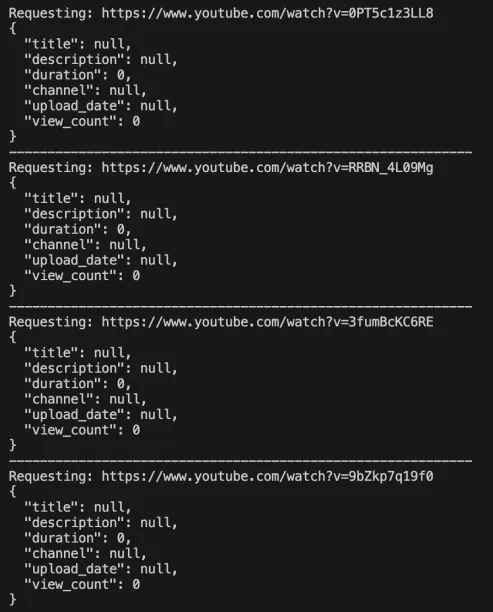This guide explains how to extract metadata from YouTube video pages programmatically using Python. We’ll walk through the core scraping logic, handling of embedded JavaScript, and proxy-based strategies to improve reliability:
| Method | Advantages | Disadvantages |
|---|---|---|
| Direct Requests | Simple setup, no extra costs | Easily blocked, unreliable for scaling |
| Residential proxies | Good balance of speed and reliability | Occasional timeouts or failed connections |
| Unblocker proxies | Improved reliability, consistent | Slightly slower, usually paid services |
This technique does not use the official YouTube API, relying instead on publicly accessible HTML and JSON structures.
Benchmark results
We evaluated both proxy-based methods by sending 20 consecutive requests to the same YouTube video.
| Proxy Type | Requests | Successful | Failed | Success Rate | Avg. Response Time (s) |
|---|---|---|---|---|---|
| Residential Proxy | 20 | 19 | 1 | 95% | 2.63 |
| Unblocker Proxy | 20 | 20 | 0 | 100% | 3.48 |
Failures included timeout and broken read errors, such as:
- Connection broken: IncompleteRead(1342 bytes read, 7545 more expected)
YouTube scraping methodology
The goal is to collectthe main metadata from YouTube videos, including:
- Title
- Description
- Duration
- Channel name
- Upload date
- View count
We performed multiple scraping methods:
- Direct requests without proxy
- Requests routed through residential proxies
- Requests routed through unblocker proxies (anti-bot solutions)
1. Basic HTML parsing method (without proxy)
Step 1: Define the video URL and HTTP headers
Custom User-Agent is used to simulate a real browser, which helps prevent the request from being flagged as automated.
url = "https://www.youtube.com/watch?v=jNQXAC9IVRw"
headers = {
"User-Agent": "Mozilla/5.0 (...) Chrome/123.0.0.0 Safari/537.36"
}Step 2: Send the GET request
We send an HTTP request to the YouTube video page and receive the raw HTML content.
response = requests.get(url, headers=headers)
html = response.textStep 3: Locate and extract the embedded JSON
YouTube includes a JavaScript object called ytInitialPlayerResponse in the HTML. This object contains most of the video metadata. We use a regular expression to extract it.
match = re.search(r"ytInitialPlayerResponse\s*=\s*(\{.+?\});", html)Step 4: Parse the JSON and extract metadata
The extracted JSON string is parsed into a Python dictionary. Two key substructures provide the relevant data:
- videoDetails contains core metadata such as the video title, full description, channel name, duration, and view count.
- microformat includes supplementary details like the upload date.
player_data = json.loads(match.group(1))
video_details = player_data.get("videoDetails", {})
microformat = player_data.get("microformat", {}).get("playerMicroformatRenderer", {})Note: The title and description are always present in the same embedded JSON structure and are not spread across multiple HTML elements.
Also, although YouTube’s web interface may visually collapse long descriptions, the full text is available in the raw HTML and does not require additional steps to access.
Step 5: Display the extracted metadata
Each field is accessed using .get() to avoid KeyErrors in case of missing data. The duration is extracted in full seconds (e.g., 1647), and the upload date is returned in ISO 8601 format (e.g., 2025-02-06T11:56:18-08:00) even for recently uploaded videos.
print("Title:", video_details.get("title"))
print("Description:", video_details.get("shortDescription"))
print("Duration (sec):", video_details.get("lengthSeconds"))
print("Channel Name:", video_details.get("author"))
print("Upload Date:", microformat.get("uploadDate"))
print("View Count:", video_details.get("viewCount"))Results of scraping YouTube without using a proxy:

2. Improving reliability with proxies
Scraping YouTube at scale using direct requests can quickly lead to IP blocks or throttling. To mitigate this, we added support for proxy-based approaches.
Residential proxy integration:
proxies = {
"http": "http://username:password@residential-proxy-ip:port",
"https": "http://username:password@residential-proxy-ip:port"
}
response = requests.get(url, headers=headers, proxies=proxies, timeout=15, verify=False)This setup uses rotating residential IP addresses to mimic organic traffic.
- timeout=15 ensures the request doesn’t hang indefinitely.
- verify=False disables SSL certificate checks, which is helpful if the proxy uses a self-signed cert.
Note: With residential proxies, approximately 90–95% of requests succeeded. Occasional timeouts or connection errors were observed.
Results from scraping YouTube using a proxy

3. Unblocker proxy integration
proxies = {
"http": "http://username:password@unblocker-proxy-ip:port",
"https": "http://username:password@unblocker-proxy-ip:port"
}
response = requests.get(url, headers=headers, proxies=proxies, timeout=15, verify=False)Unblocker proxies are built to bypass advanced anti-bot mechanisms, including JavaScript challenges and dynamic rendering layers such as Cloudflare.
Note: This configuration achieved a 100% success rate in testing, making it ideal for production-grade or large-scale scraping applications. Response times were slightly slower compared to residential proxies.
YouTube scraping results using an unblocker

Alternative: Using third-party YouTube scraper APIs
Web scraping APIs eliminate the need for in-house infrastructure, including development, testing, and maintenance, making them a scalable and cost-efficient alternative. Platforms like YouTube employ rate limiting, and CAPTCHA challenges to detect and block automated scrapers. To avoid IP bans, custom scrapers must implement proxy rotation strategies, but managing proxies and bypassing CAPTCHAs requires significant effort. For instance, maintaining load balancing across multiple IPs adds complexity to scaling operations.
Additionally, API providers may not support all data types, and the depth of collected data can vary. Before selecting a pre-built scraping API, ensure it aligns with your specific data extraction requirements for different page types.
For example, a third-party YouTube scraper API charges $0.0010 to $0.0050 per request. Scraping 10 million pages per month would cost over $10,000 to $50,000 at an average API charge of $0.003 per page.
Free YouTube Data API for developers
YouTube Data API v3 offers free access to YouTube data, allowing developers to build apps that interact with YouTube. The API allows you to interface with several types of resources, including activity, channel, playlist, search result, subscription, and thumbnails. Here’s an outline of how to get started using the YouTube Data API:
- First, you need to gain API access. Go to the Google Cloud Console and create a new project. 1
Enable the YouTube Data API version 3. - Select Your Authentication Method: API key (public data) or OAuth 2.0 (private user data).
- Choose your client library (Java, PHP, or Python) to make API queries.
Rate limits: YouTube Data API contains rate constraints to ensure that users do not construct apps that unfairly impair service quality or restrict access to other users. API requests have a daily quota of 10,000 units. Quota Consumption:
- Searching for video: 100 units per request
- Obtaining video details: one unit per request.
- Obtaining channel information: 1 unit per request.
- Fetching comments: one unit per request
Conclusion
HTML-based scraping of YouTube metadata is a viable and lightweight alternative to the official API, particularly when proxy infrastructure is used. While direct requests may work for small, infrequent tasks, they are not sustainable at scale due to IP blocks.
For long-term use:
- Residential proxies offer speed and fair reliability.
- Unblocker proxies provide the highest stability, ideal for automated pipelines or production systems.
FAQs about YouTube scraping
Is it legal to scrape YouTube data?
Scraping publicly available data from YouTube is a legal gray area. While YouTube’s terms of service prohibit automated access without explicit permission, no laws are directly violated by simply reading publicly served HTML.
What kind of data can be extracted from YouTube?
You can extract metadata such as:
* Title
* Description (full text, not just preview)
* Video duration
* Channel name
* Upload date
* View count
How reliable is scraping without a proxy?
Direct scraping without a proxy may work briefly, especially for low-volume tasks. However, repeated access will likely trigger YouTube’s anti-bot mechanisms.
What’s the difference between residential and unblocker proxies?
Residential Proxies: Use real IPs and are effective at mimicking normal browsing behavior.
Unblocker Proxies: Purpose-built to bypass advanced bot protections and dynamic challenges (e.g., Cloudflare, JavaScript checks).

Comments
Your email address will not be published. All fields are required.